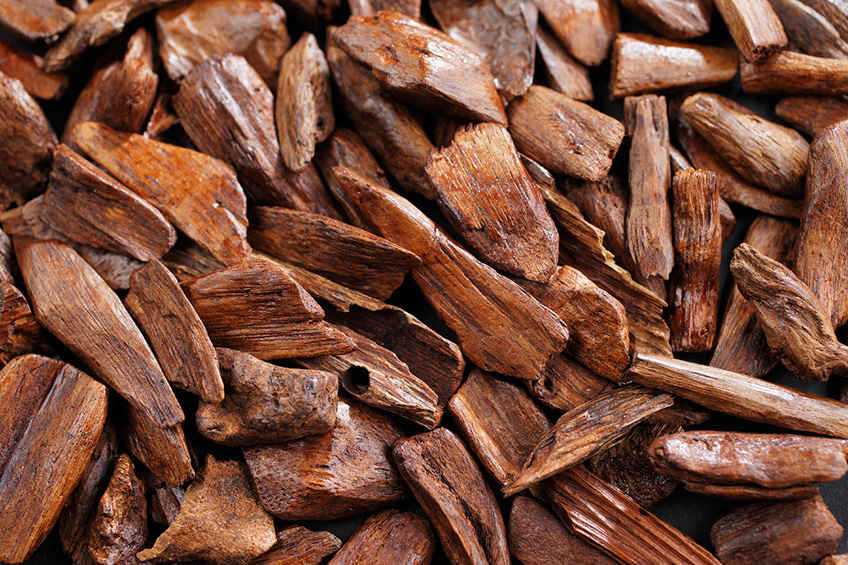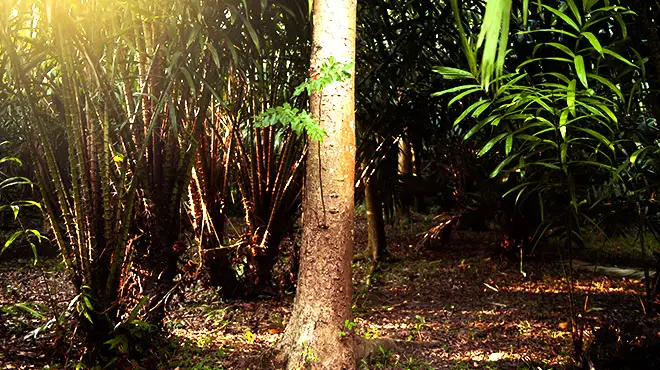Oud comes from the resinous heartwood of the Aquilaria tree found in South and Southeast Asia. Known for its strong, woody aroma, oud is widely used in perfumes and incense.
Oud, also known as agarwood, is a highly valued and sought-after material derived from the heartwood of the Aquilaria tree. This aromatic tree is native to certain regions in South and Southeast Asia, including countries like India, Cambodia, Malaysia, and Indonesia.
Oud is produced when the Aquilaria tree becomes infected with a particular type of mold, triggering a response in the tree that results in the formation of resinous substances. These resins permeate the heartwood, gradually transforming it into the highly prized oud. Renowned for its rich and captivating fragrance, oud has been used for centuries in the production of perfumes, incense, and other luxury products. Its distinct woody scent, often described as complex and sensual, has made it a valuable ingredient in the global fragrance industry.

Credit: naturalnicheperfume.com
The Ancient Beginnings Of Oud Perfume
Oud, a highly prized perfume ingredient, has ancient origins that date back centuries. Its production involves the intricate art of distillation. This process extracts the fragrant essence from the wood of agarwood trees. Oud has played a significant role in various ancient civilizations, with its distinctive scent often associated with luxury and spirituality.
Its rich history and cultural importance have made oud a sought-after ingredient in perfumes and incense. The use of oud can be traced back to ancient civilizations such as Egypt, India, and China, where it was treasured for its aromatic properties.
Today, oud continues to captivate perfume enthusiasts worldwide, its allure rooted in its long-standing traditions. The intricate process of distilling oud has been passed down through generations, ensuring that this ancient art form continues to thrive, delighting fragrance lovers across the globe.
Oud Production Across The Middle East And Asia
Oud, a highly coveted fragrant wood, is sourced from various regions around the world. In the Middle East, oud holds immense cultural significance and is considered a symbol of luxury and status. With its deep-rooted history, the Middle East has long been associated with the production of oud, nurturing a craftsmanship that has been passed down through generations.
Southeast Asia, particularly countries like Indonesia and Cambodia, has also emerged as a prominent player in the oud industry. These regions offer the ideal climate and conditions for agarwood trees to thrive, resulting in exceptional quality oud. The demand for oud has soared in recent years, thanks to its distinctive scent and allure.
As its popularity continues to rise, the search for oud has expanded to include various parts of the world, ensuring a steady supply of this precious and enchanting natural resource. Oud truly captivates the senses with its mesmerizing aroma, taking us on a sensory journey that spans continents.
Exploring The Oud Trade Routes
Oud, also known as agarwood, is a highly sought-after commodity with a fascinating journey from forests to markets around the world. This aromatic resin is derived from the Aquilaria tree, which primarily grows in Southeast Asia, especially in countries like Cambodia, Vietnam, and Thailand.
However, oud is not limited to this region alone. The oud trade routes stretch far and wide, reaching places like India, Bangladesh, and even as far as China. Over the centuries, merchants and traders have embarked on daring expeditions, navigating treacherous terrains and traversing vast oceans to acquire this precious substance.
Today, oud is a global commodity, with demand surging not only in the Middle East, where it is highly valued for its luxurious fragrance, but also in Western markets. This captivating journey of oud reflects the international appeal and enduring legacy of this aromatic treasure.
Understanding The Oud Distillation Methods
Oud, also known as agarwood, is a highly sought-after fragrance ingredient with a rich history. The distillation methods used to extract this precious oil have evolved over time. One traditional technique is steam distillation, where steam is passed through the oud chips to release the aromatic compounds.
This method is time-consuming but produces a high-quality oil. On the other hand, modern techniques involve solvent extraction, where organic solvents are used to dissolve the aromatic compounds from the oud chips. This method is faster and more efficient, but the resulting oil may have a slightly different scent profile.
Both methods have their own merits and are used by perfumers and fragrance houses worldwide to create the captivating scent of oud. Understanding these distillation techniques helps to appreciate the craftsmanship and passion behind every bottle of oud fragrance.
The Role Of Agarwood In Oud Production
Agarwood, also known as oud, is a highly sought-after and prized fragrance ingredient. The role of agarwood in oud production is paramount. Agarwood formation is a natural phenomenon that occurs in certain species of trees when they become infected with a specific mold.
This infection triggers the tree to produce a resin, which eventually hardens and turns into agarwood. The quality of agarwood plays a significant role in determining the overall quality of oud. The aroma and potency of oud are directly influenced by the quality of agarwood used in its production.
Producers carefully select and process agarwood to extract its essential oils, which are then used in perfumes, incense, and other products. Understanding agarwood’s natural formation and its significance in oud production is crucial for appreciating this unique and luxurious fragrance ingredient.
Sustainability And Conservation Efforts
Oud, also known as agarwood, is a highly prized fragrance ingredient derived from the Aquilaria tree. Sustainable practices aim to balance oud production with environmental conservation efforts. By prioritizing sustainable sourcing, the future of oud ensures the longevity of this precious resource.
By implementing strict regulations and promoting responsible harvesting methods, the fragrance industry strives to protect the Aquilaria tree populations. Oud production must be managed carefully to avoid excessive exploitation and safeguard the delicate ecosystems that support these trees. Conservation efforts are crucial in maintaining the ecological balance while meeting the demand for this sought-after fragrance.
With mindful practices, we can ensure that oud remains available for generations to come, highlighting the importance of sustainable development and ethical sourcing in the fragrance industry. The future of oud sustainability depends on our collective commitment to preserving nature’s invaluable resources.
Discovering Different Types Of Oud
Oud, also known as agarwood, originates from the Southeast Asian region. It is obtained from the Aquilaria tree, which is renowned for its aromatic resin. Among the various types of oud, Aquilaria Malaccensis holds a significant position as the epitome of oud.
This variety is often referred to as the “King of Oud” due to its exceptional fragrance and rarity. Another notable type is Aquilaria Crassna, which hails from Vietnam, and is widely recognized for its distinct essence. These different varieties of oud offer unique olfactory experiences and are highly sought after in the perfume industry.
The process of extracting oud involves the infection of the Aquilaria tree, triggering the production of the resin. This natural and captivating ingredient has gained a prominent place in the world of luxury fragrances.
Exploring Oud Blends And Variations
Oud, also known as agarwood, is derived from the resinous heartwood of the Aquilaria tree. This precious and aromatic material has been used in perfumery for centuries. Oud blends and variations are an art form, carefully crafted to create unique olfactory experiences.
Perfumers combine oud with other ingredients, both classic and modern, to achieve harmonious compositions. The timeless allure of oud can be found in traditional fragrances, where it adds a rich and exotic dimension. However, it also lends itself well to modern interpretations, blending with contemporary notes to create innovative scent profiles.
The possibilities are endless when it comes to oud and perfumery, offering a wide range of aromatic combinations to suit different tastes and preferences. Whether you prefer the classic or the modern, oud has the power to captivate and transport you on a fragrant journey.
Oud In Traditional Music And Ceremonies
Oud, a stringed musical instrument, has a significant presence in Middle Eastern music traditions. It is commonly used in religious and cultural ceremonies, adding a distinct flavor to the performances. The origins of oud can be traced back to ancient Mesopotamia, and it has played a crucial role in the development of traditional music across the region.
The enchanting melodies produced by the oud captivate listeners, transporting them to a different era. In religious ceremonies, the instrument takes on a sacred quality, invoking a sense of spirituality and reverence. Similarly, in cultural ceremonies, the oud sets the tone for celebrations and rituals, creating a festive atmosphere.
Whether it is a solemn religious occasion or a joyous cultural event, the oud is an integral part of the Middle Eastern musical tradition, enriching the overall experience.
Oud: A Symbol Of Luxury And Prestige
Oud, a symbol of luxury and prestige, holds a special place in the world of high-end perfumery. Revered for its rich and captivating fragrance, oud has become a prized ingredient in the creation of luxurious scents. Derived from the agarwood tree, primarily found in Southeast Asia, the process of extracting oud is both intricate and time-consuming.
As a result, oud-based perfumes are often associated with exclusivity and sophistication. In addition to its use in perfumery, oud has made its way into the world of luxury goods. From high-end boutiques to opulent home decor, the allure of oud has extended beyond the realm of fragrance.
For those seeking to indulge in the finest and most extravagant experiences, oud is the epitome of luxury.
Frequently Asked Questions
Why Is Oud So Expensive?
Oud is expensive due to its rarity, high demand, intricate extraction process, and the quality of the wood.
Why Do Muslims Use Oud?
Muslims use oud for its deep cultural and religious significance in fragrances and traditional ceremonies.
Which Country Is Famous For Oud?
The country known for oud is Malaysia, famous for its high-quality production of the fragrant resin.
What Does An Oud Fragrance Smell Like?
Oud fragrance has a unique smell, which is warm, woody, and slightly sweet with hints of smoke and earth.
Conclusion
Oud, also known as agarwood, is a highly prized and sought-after aromatic resin that comes from the heartwood of the Aquilaria tree. This rare and precious wood has a rich and complex fragrance that is used in various applications, such as perfumes, incense, and traditional medicine.
Oud has a long and fascinating history, with its origins traced back to the Middle East and South Asia. Over the centuries, oud has become synonymous with luxury and opulence, captivating the hearts and senses of people worldwide. The production of oud is an intricate and delicate process that requires expert craftsmanship.
From the careful selection of mature Aquilaria trees to the precise extraction of the resin, each step is carried out with meticulous attention to detail. The scarcity and labor-intensive nature of oud production contribute to its high value and exclusivity.
Whether you are a fragrance enthusiast or a curious explorer, understanding the origins of oud adds depth to your appreciation of its allure. From the ancient civilizations that first discovered its captivating aroma to the modern-day artisans who continue to preserve and innovate with this natural treasure, the journey of oud is a testament to the enduring fascination of nature’s fragrant gifts.








